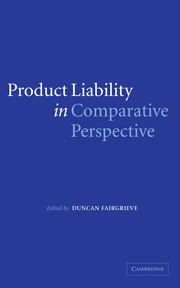1 - Introduction
Published online by Cambridge University Press: 28 July 2009
Summary
Product liability and overlapping interests
The essence of product liability is the apportionment of the risks inherent in the modern mass production of consumer goods. A choice must be made as to who should bear these risks: the victim, the state or the manufacturer?
Despite this apparent simplicity, the law of product liability is indeed a complex one, lying as it does on the overlap of a series of different matrices. In terms of substantive law, the law of contract and the law of tort make up one layer of rules, with oft-conflicting concepts and approaches. To this, a supranational stratum has been added. The European Directive on Product Liability has brought an important dimension of European Community law, with the introduction of terms often alien to the national systems, such as ‘putting into circulation’ or ‘defect’, as well as the technical debates over competence and levels of harmonisation brought about by the European legislation. The law of product liability is further complexified due to the superposition of a myriad of other domestic rules stemming from the broader legal framework of consumer law, procedures governing damages claims, and, in some scenarios, the application of notions of public law.
This complex legal framework must also be set within the broader policy debate. The framing of product liability regulation has been underpinned by a stark debate with conflicting viewpoints, on occasion characterised as a struggle of consumer versus industry.
- Type
- Chapter
- Information
- Product Liability in Comparative Perspective , pp. 1 - 10Publisher: Cambridge University PressPrint publication year: 2005
- 2
- Cited by



